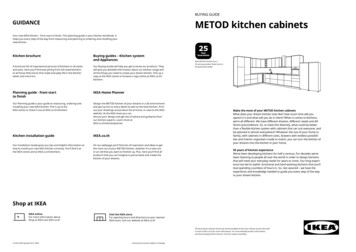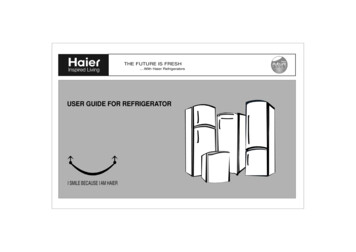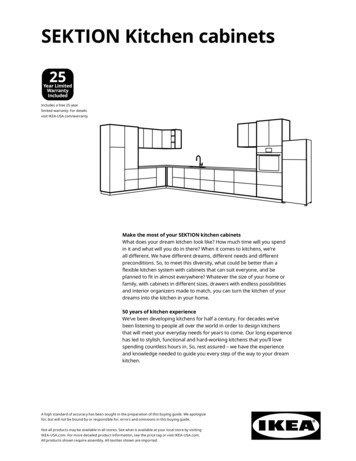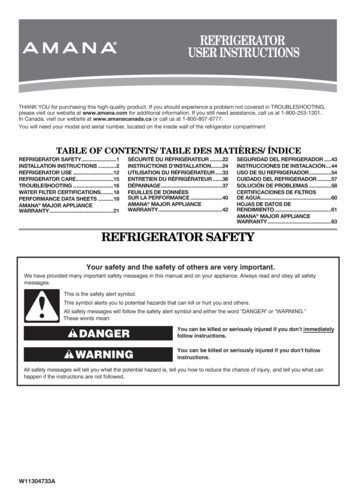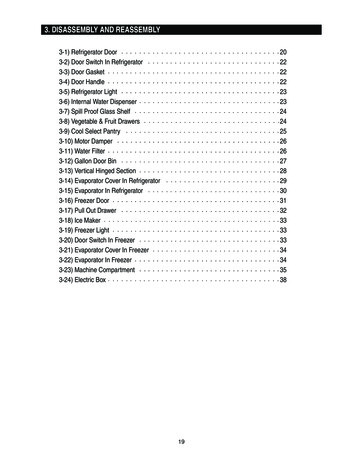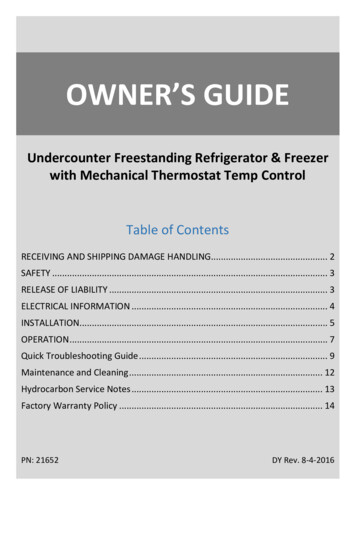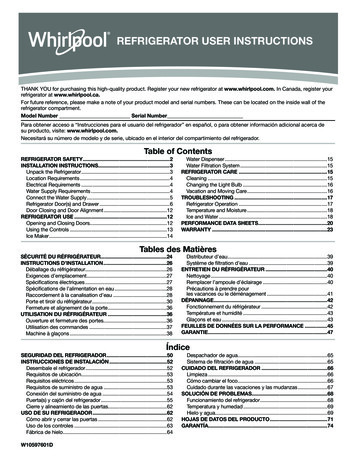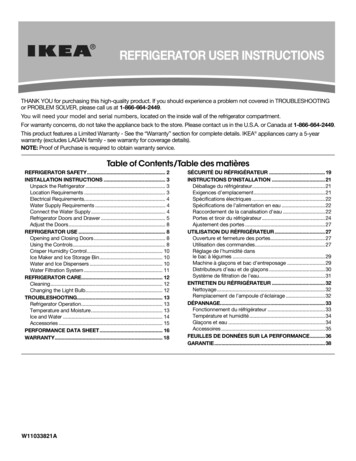
Transcription
REFRIGERATOR USER INSTRUCTIONSTHANK YOU for purchasing this high-quality product. If you should experience a problem not covered in TROUBLESHOOTINGor PROBLEM SOLVER, please call us at 1-866-664-2449.You will need your model and serial numbers, located on the inside wall of the refrigerator compartment.For warranty concerns, do not take the appliance back to the store. Please contact us in the U.S.A. or Canada at 1-866-664-2449.This product features a Limited Warranty - See the “Warranty” section for complete details. IKEA appliances carry a 5-yearwarranty (excludes LAGAN family - see warranty for coverage details).NOTE: Proof of Purchase is required to obtain warranty service.Table of Contents/Table des matièresREFRIGERATOR SAFETY. 2INSTALLATION INSTRUCTIONS . 3Unpack the Refrigerator . 3Location Requirements . 3Electrical Requirements. 4Water Supply Requirements . 4Connect the Water Supply . 4Refrigerator Doors and Drawer . 5Adjust the Doors. 8REFRIGERATOR USE . 8Opening and Closing Doors. 8Using the Controls. 8Crisper Humidity Control. 10Ice Maker and Ice Storage Bin. 10Water and Ice Dispensers . 10Water Filtration System . 11REFRIGERATOR CARE. 12Cleaning. 12Changing the Light Bulb. 12TROUBLESHOOTING. 13Refrigerator Operation. 13Temperature and Moisture. 13Ice and Water . 14Accessories . 15PERFORMANCE DATA SHEET. 16WARRANTY. 18W11033821ASÉCURITÉ DU RÉFRIGÉRATEUR .19INSTRUCTIONS D’INSTALLATION .21Déballage du réfrigérateur.21Exigences d’emplacement.21Spécifications électriques .22Spécifications de l’alimentation en eau .22Raccordement de la canalisation d’eau .22Portes et tiroir du réfrigérateur .24Ajustement des portes .27UTILISATION DU RÉFRIGÉRATEUR.27Ouverture et fermeture des portes.27Utilisation des commandes.27Réglage de l’humidité dansle bac à légumes .29Machine à glaçons et bac d’entreposage .29Distributeurs d’eau et de glaçons .30Système de filtration de l’eau.31ENTRETIEN DU RÉFRIGÉRATEUR .32Nettoyage .32Remplacement de l’ampoule d’éclairage .32DÉPANNAGE.33Fonctionnement du réfrigérateur .33Température et humidité.34Glaçons et eau .34Accessoires .35FEUILLES DE DONNÉES SUR LA PERFORMANCE.36GARANTIE.38
REFRIGERATOR SAFETYYour safety and the safety of others are very important.We have provided many important safety messages in this manual and on your appliance. Always read and obey all safetymessages.This is the safety alert symbol.This symbol alerts you to potential hazards that can kill or hurt you and others.All safety messages will follow the safety alert symbol and either the word “DANGER” or “WARNING.”These words mean:DANGERWARNINGYou can be killed or seriously injured if you don't immediatelyfollow instructions.You can be killed or seriously injured if you don't followinstructions.All safety messages will tell you what the potential hazard is, tell you how to reduce the chance of injury, and tell you what canhappen if the instructions are not followed.IMPORTANT SAFETY INSTRUCTIONSWARNING: To reduce the risk of fire, electric shock, or injury when using your refrigerator, follow these basic precautions: Plug into a grounded 3 prong outlet. Do not remove ground prong. Do not use an adapter. Disconnect power before installing ice maker (on ice makerkit ready models only).Use a sturdy glass when dispensing ice (on some models). Do not use an extension cord. Do not hit the refrigerator glass doors (on some models).Disconnect power before servicing. This appliance is not intended for use by persons (includingchildren) with reduced physical, sensory or mentalcapabilities, or lack of experience and knowledge, unlessthey have been given supervision or instruction concerninguse of the appliance by a person responsible for theirsafety.Children should be supervised to ensure that they do notplay with the appliance. Replace all parts and panels before operating. Remove doors from your old refrigerator. Connect to a potable water supply only. Use nonflammable cleaner. Keep flammable materials and vapors, such as gasoline,away from refrigerator.Use two or more people to move and install refrigerator. SAVE THESE INSTRUCTIONSState of California Proposition 65 Warnings:WARNING: This product contains one or more chemicals known to the State of California to cause cancer.WARNING: This product contains one or more chemicals known to the State of California to cause birth defects or otherreproductive harm.Proper Disposal of Your Old RefrigeratorWARNINGSuffocation HazardRemove doors from your old refrigerator.Failure to do so can result in death or brain damage.IMPORTANT: Child entrapment and suffocation are not problemsof the past. Junked or abandoned refrigerators are still dangerous– even if they will sit for “just a few days.” If you are getting rid of2your old refrigerator, please follow these instructions to helpprevent accidents.Before You Throw Away Your Old Refrigerator or Freezer: Take off the doors.Leave the shelves in place so that children may not easilyclimb inside.
Important information to know about glass shelvesand covers:Do not clean glass shelves or covers with warm water whenthey are cold. Shelves and covers may break if exposed tosudden temperature changes or impact, such as bumping.Tempered glass is designed to shatter into many small,pebble-size pieces. This is normal. Glass shelves and coversare heavy. Use both hands when removing them to avoiddropping.Location RequirementsImportant information to know about disposal ofrefrigerants:Dispose of refrigerator in accordance with Federal and Localregulations. Refrigerants must be evacuated by a licensed,EPA certified refrigerant technician in accordance withestablished n HazardKeep flammable materials and vapors, such asgasoline, away from refrigerator.Failure to do so can result in death, explosion, or fire.Unpack the RefrigeratorWARNINGExcessive Weight HazardUse two or more people to move and installrefrigerator.Failure to do so can result in back or other injury.Remove the Packaging Remove tape and glue residue from surfaces before turningon the refrigerator. Rub a small amount of liquid dish soapover the adhesive with your fingers. Wipe with warm waterand dry.Do not use sharp instruments, rubbing alcohol, flammablefluids, or abrasive cleaners to remove tape or glue. Theseproducts can damage the surface of your refrigerator. Formore information, see “Refrigerator Safety.”Dispose of/recycle all packaging materials.IMPORTANT: This refrigerator is designed for indoor, householduse only.To ensure proper ventilation for your refrigerator, allow for a¹ ₂" (1.25 cm) of space on each side and at the top. Allow for a1" (2.54 cm) space behind the refrigerator. If your refrigerator hasan ice maker, allow extra space at the back for the water lineconnections. When installing your refrigerator next to a fixed wall,leave a 3³ ₄" (9.5 cm) minimum space between the refrigerator andwall to allow the door to swing open.NOTE: This refrigerator is intended for use in a location where thetemperature ranges from a minimum of 55 F (13 C) to a maximumof 110 F (43 C). The preferred room temperature range foroptimum performance, which reduces electricity usage andprovides superior cooling, is between 60 F (15 C) and 90 F(32 C). It is recommended that you do not install the refrigeratornear a heat source, such as an oven or radiator.When Moving Your Refrigerator:Your refrigerator is heavy. When moving the refrigerator forcleaning or service, be sure to cover the floor withcardboard or hardboard to avoid floor damage. Always pullthe refrigerator straight out when moving it. Do not wiggle or“walk” the refrigerator when trying to move it, as floordamage could occur.¹ ₂" (1.25 cm)Clean Before UsingAfter you remove all of the packaging materials, clean the inside ofyour refrigerator before using it. See the cleaning instructions in“Refrigerator Care.”3³ ₄" (9.5 cm)3
Reverse Osmosis Water SupplyElectrical RequirementsWARNINGIMPORTANT: The pressure of the water supply coming out ofa reverse osmosis system going to the water inlet valve of therefrigerator needs to be between 35 and 120 psi (241 and827 kPa).If a reverse osmosis water filtration system is connected to yourcold water supply, the water pressure to the reverse osmosissystem needs to be a minimum of 40 to 60 psi (276 to 414 kPa).If the water pressure to the reverse osmosis system is less than40 to 60 psi (276 to 414 kPa):Electrical Shock HazardPlug into a grounded 3 prong outlet.Do not remove ground prong.Do not use an adapter.Do not use an extension cord.Failure to follow these instructions can result in death,fire, or electrical shock. Check to see whether the sediment filter in the reverseosmosis system is blocked. Replace the filter if necessary. Allow the storage tank on the reverse osmosis system to refillafter heavy usage. If your refrigerator has a water filter, it may further reducethe water pressure when used in conjunction with a reverseosmosis system. Remove the water filter. See “Water FiltrationSystem.”If you have questions about your water pressure, call a licensed,qualified plumber.Before you move your refrigerator into its final location, it isimportant to make sure you have the proper electrical connection.Connect the Water SupplyRecommended Grounding MethodRead all directions before you begin.A 115-volt, 60 Hz, AC-only 15- or 20-amp fused, groundedelectrical supply is required. It is recommended that a separatecircuit serving only your refrigerator and approved accessories beprovided. Use an outlet that cannot be turned off by a switch. Donot use an extension cord.IMPORTANT:NOTE: Before performing any type of installation, cleaning, orremoving a light bulb, turn off Cooling, and then disconnect therefrigerator from the electrical source. When you have finished,reconnect the refrigerator to the electrical source and turn onCooling. See “Using the Controls.” Water Supply RequirementsGather the required tools and parts before starting installation.Read and follow the instructions provided with any tools listedhere. TOOLS NEEDED: Flat-blade screwdriver⁷ ₁₆" and ¹ ₂" open-end ortwo adjustable wrenches ¹ ₄" nut driver¹ ₄" drill bitCordless drillIMPORTANT: All installations must meet local plumbing code requirements. Do not use a piercing-type or ³ ₁₆" (4.76 mm) saddle valvewhich reduces water flow and clogs more easily. Use copper tubing and check for leaks. Install copper tubingonly in areas where the household temperatures will remainabove freezing. For models with water filters, the disposable water filtershould be replaced at least every 6 months.Water PressureA cold water supply with water pressure between 35 and120 psi (241 and 827 kPa) is required to operate the waterdispenser and ice maker. If you have questions about yourwater pressure, call a licensed, qualified plumber.4 Plumbing shall be installed in accordance with theInternational Plumbing Code and any local codes andordinances.The gray water tubing on the back of the refrigerator (whichis used to connect to the household water line) is a PEX(cross-linked polyethylene) tube. Copper and PEX tubingconnections from the household water line to the refrigeratorare acceptable and will help avoid off-taste or odor in your iceor water. Check for leaks.If PEX tubing is used instead of copper, we recommend thefollowing part numbers:W10505928RP (7 ft [2.14 m] jacketed PEX),8212547RP (5 ft [1.52 m] PEX), orW10267701RP (25 ft [7.62 m] PEX).Install tubing only in areas where temperatures will remainabove freezing.If you turn on the refrigerator before the water line isconnected, turn off the ice maker to avoid excessive noiseor damage to the water valve.Connect to Water Line1. Unplug refrigerator or disconnect power.2. Turn off main water supply. Turn on nearest faucet longenough to clear line of water.3. Find a ¹ ₂" to 1¹ ₄" (12.7 mm to 31.8 mm) vertical cold waterpipe near the refrigerator.IMPORTANT: Make sure it is a cold water pipe. Horizontal pipe will work, but the following proceduremust be followed: Drill on the top side of the pipe, not thebottom. This will help keep water away from the drill. Thisalso keeps normal sediment from collecting in the valve.4. Determine the length of copper tubing you need. Measurefrom the connection on the lower right rear of the refrigeratorto the water pipe. Add 7 ft (2.1 m) to allow for cleaning. Use¹ ₄" (6.35 mm) O.D. (outside diameter) copper tubing. Be sureboth ends of copper tubing are cut square.
5. Using a cordless drill, drill a ¹ ₄" hole in the cold water pipeyou have selected.Complete the InstallationAWARNINGBCDEFGA. Cold water pipeB. Pipe clampC. Copper tubingD. Compression nutElectrical Shock HazardE. Compression sleeveF. Shut-off valveG. Packing nutPlug into a grounded 3 prong outlet.Do not remove ground prong.Do not use an adapter.6. Fasten the shut-off valve to the cold water pipe with the pipeclamp. Be sure the outlet end is solidly in the ¹ ₄" drilled holein the water pipe and that the washer is under the pipe clamp.Tighten the packing nut. Tighten the pipe clamp screwsslowly and evenly so the washer makes a watertight seal.Do not overtighten.7. Slip the compression sleeve and compression nut on thecopper tubing as shown. Insert the end of the tubing into theoutlet end squarely as far as it will go. Screw compression nutonto outlet end with adjustable wrench. Do not overtighten oryou may crush the copper tubing.8. Place the free end of the tubing in a container or sink, and turnon the main water supply. Flush the tubing until water is clear.Turn off the shut-off valve on the water pipe.Do not use an extension cord.Failure to follow these instructions can result in death,fire, or electrical shock.1. Plug into a grounded 3 prong outlet.NOTE: Allow 24 hours to produce the first batch of ice. Discardthe first three batches of ice produced. Allow 3 days to completelyfill the ice container.Refrigerator Doors and DrawerAll graphics referenced in the following instructions are includedlater in this section after “Final Steps.”TOOLS NEEDED: ⁵ ₁₆", ³ ₈", ¹ ₄" hex-head socket wrench,#2 Phillips screwdriver, and a flat-blade screwdriverConnect to Refrigerator1. Remove plastic cap from water valve inlet port. Attach thecopper tube to the valve inlet using a compression nut andsleeve as shown. Tighten the compression nut. Do notovertighten. Confirm copper tubing is secure by pullingon copper tubing.2. Create a service loop with the copper tubing. Avoid kinkswhen coiling the copper tubing. Secure copper tubing torefrigerator cabinet with a “P” clamp.IMPORTANT: AB Your refrigerator may have a standard reversible refrigeratordoor with either a freezer door or freezer drawer or Frenchdoors. Follow the instructions specific to the door style of yourmodel.All graphics referenced in the following instructions areincluded later in this section after “Final Steps.” The graphicsshown for the standard door are for a right-hand swingrefrigerator (hinges factory installed on the right).If you only want to remove and replace the doors, see“Remove Door(s) and Hinges” and “Replace Door(s) andHinges.”Before you begin, turn the refrigerator control off and removefood and adjustable door or utility bins from the doors.CRemove and Replace HandlesD A. Copper tubingB. “P” clampUsing a ³ 32" or 1 ₈" hex key, loosen the two setscrews locatedon the side of each handle. Pull the handle straight out fromthe door. Make sure you keep the screws for reattaching thehandles. See Handles, graphic 1.To replace the handles, reverse the directions.C. Compression nutD. Compression sleeve3. Turn on water supply to refrigerator and check for leaks.Correct any leaks.5
Remove Doors and HingesIMPORTANT: Remove food and any adjustable door or utility binsfrom doors.WARNING3. Align the door so that the bottom of the refrigerator dooraligns evenly with the top of the freezer drawer. Tighten allscrews.4. Reconnect the wiring plug on top of the left-hand siderefrigerator door.5. Reconnect the water line by pulling back the locking collarring while firmly pushing the water line into the connector.6. Check for leaks. Replace the top hinge covers.Remove and Replace Freezer DrawerIMPORTANT: Two people may be required to remove and replacethe freezer drawer. Graphics are included later in this section.Electrical Shock HazardDisconnect power before removing doors.Failure to do so can result in death or electrical shock.1. Unplug refrigerator or disconnect power.2. Keep the refrigerator doors closed until you are ready to liftthem free from the cabinet.NOTE: Provide additional support for the refrigerator doorwhile the hinges are being removed. Do not depend on thedoor gasket magnets to hold the door in place while you areworking.3. Starting with the right-hand side door, remove the parts forthe top hinge as shown in Top Hinges graphic. Lift therefrigerator door from the bottom hinge pin.4. Remove top hinge cover from left side refrigerator door.5. Disconnect the wiring plug located on top of the hinge bywedging a flat-blade screwdriver or your fingernail betweenthe two sections. See Connections graphic.6. Disconnect the water line by pulling back on the locking collarwhile pulling the water line out of the water line connector.See Connections graphic.7. Remove the parts for the top hinge as shown in Top Hingesgraphic. Lift the left-hand side door from the bottom hingepin.8. Remove the base grille. Grasp the grille firmly and pull ittoward you.Remove Drawer Front1. Open the freezer drawer to full extension.2. Loosen the four screws attaching the drawer glides to thedrawer front. See Drawer Front Removal graphic.NOTE: Loosen screws three to four turns. Keep the screws inthe drawer front.3. Lift drawer front upward and off the screws. See Drawer FrontRemoval graphic.Replace Drawer Front1. Slide the drawer glides out of the freezer compartment. Insertthe screws in the top of the drawer front into the slots in thedrawer brackets. See Drawer Front Replacement graphic.2. Pull the drawer brackets toward you to position the twoscrews in the bottom of the drawer front into the brackets.See Drawer Front Replacement graphic.3. Completely tighten the four screws.Final Steps1. Replace the base grille.WARNINGElectrical Shock HazardPlug into a grounded 3 prong outlet.Do not remove ground prong.Do not use an adapter.9. Using a ³ ₈" hex wrench, remove the leveling leg brackets fromthe bottom of the cabinet. Keep screws for later use.Replace Doors and Hinges1. Assemble the parts for the top hinge as shown in Top Hingesgraphic. Do not tighten the screws completely.2. Replace the parts for the bottom hinge as shown in BottomHinges graphic. Tighten screws. Replace the refrigeratordoor.NOTE: Provide additional support for the refrigerator doorwhile the hinges are being moved. Do not depend on the doorgasket magnets to hold the door in place while you areworking.6Do not use an extension cord.Failure to follow these instructions can result in death,fire, or electrical shock.2. Plug into a grounded 3 prong outlet.3. Return all removable parts to doors and drawer and food torefrigerator and freezer.
WARNINGElectrical Shock HazardDisconnect power before removing doors.Failure to do so can result in death or electrical shock.Door Removal & Replacement1Top HingesABHandlesCDAA. Hinge Cover ScrewB. Top Hinge CoverC. 5/16" Hex-Head Hinge ScrewsD. Top HingeBottom HingesA. 3/32" SetscrewABCA. Hinge Pin CoverB. Bottom HingeC. Hinge ScrewsConnectionsA2HandleBA. Wiring PlugB. Water Line ConnectionDrawer Front RemovalAA. 3/32" SetscrewDrawer Front ReplacementAA. Loosen 4 Door Bracket Screws7
Adjust the DoorsIMPORTANT: Your refrigerator has two adjustable, front leveling screws –one on each side of the refrigerator base. If your refrigeratorseems unsteady or you want the door to close easier, use theinstructions below. Before moving the refrigerator, raise the leveling screws so thefront rollers are touching the floor.1. Remove the two screws fastening the base grille to thecabinet, and set the screws aside. Grasp the grille and pullit toward you.REFRIGERATOR USEOpening and Closing DoorsThere are two refrigerator compartment doors. The doors can beopened and closed either separately or together.There is a vertically hinged seal on the left refrigerator door. When the left-hand refrigerator door is opened, the hingedseal automatically folds inward so that it is out of the way.When both doors are closed, the hinged seal automaticallyforms a seal between the two doors.A2. Raise or lower the cabinet.Using a ¹ ₄" hex driver, turn the leveling screw on each sideto raise or lower that side of the refrigerator.NOTE: Having someone push against the top of therefrigerator takes some weight off the leveling screws. Thismakes it easier to turn the screws. It may take several turnsof the leveling screw to adjust the tilt of the refrigerator. To raise, turn the leveling screw clockwise. To lower, turn the leveling screw counterclockwise.¹ ₄"A. Hinged sealUsing the ControlsThe refrigerator and freezer controls are located on the dispenserpanel.IMPORTANT: The display screen on the dispenser control panelwill turn off automatically and enter “sleep” mode when thecontrol buttons and dispenser levers have not been used for2 minutes or more. While in “sleep” mode, the first press of acontrol button will only reactivate the display screen withoutchanging any settings. After reactivation, changes to any settingscan then be made. If no changes are made within 2 minutes, thedisplay will re-enter “sleep” mode. ABA. Leveling screwB. Front roller3. Open the door again to make sure that it closes as easily asyou like. If not, tilt the refrigerator slightly more to the rear byturning both leveling screws clockwise. It may take severalmore turns, and you should turn both screws the sameamount.4. Replace the base grille.8Touch any control button on the dispenser panel to activatethe display screen. The home screen will appear as shown.
Adjusting the ControlsWhen adjusting temperature set points, use the following chart asa guide.For your convenience, your refrigerator and freezer controls arepreset at the factory. When you first install your refrigerator, makesure that the controls are still set to the “mid-settings.” Thefactory-recommended set points are 38 F (3 C) for the refrigeratorand 0 F (-18 C) for the freezer.IMPORTANT: Wait 24 hours before you put food into the refrigerator. If youadd food before the refrigerator has cooled completely, yourfood may spoil.NOTE: Adjusting the set points to a colder-thanrecommended setting will not cool the compartmentsany faster. If the temperature is too warm or too cold in the refrigeratoror freezer, first check the air vents to be sure they are notblocked before adjusting the controls. The preset temperatures should be correct for normalhousehold usage. The controls are set correctly when milkor juice is as cold as you like and when ice cream is firm. Wait at least 24 hours between adjustments. Recheck thetemperatures before other adjustments are made.To view and adjust the set points, press and hold the TEMPbutton for 3 seconds. When Adjust mode is activated, adjustinginformation will appear on the display R too coldREFRIGERATOR setting1 higherREFRIGERATOR too warmREFRIGERATOR setting1 lowerFREEZER too coldFREEZER setting1 higherFREEZER too warm/too little iceFREEZER setting1 lowerThe set-point range for the refrigerator is 33 F to 45 F (0 C to7 C). The set-point range for the freezer is -5 F to 5 F (-21 C to-15 C).Cooling On/OffYour refrigerator and freezer will not cool when cooling isturned off. To turn cooling off, press and hold the LOCK and FILTERbuttons at the same time for 3 seconds. When cooling is off,“COOLING OFF” will appear on the display screen.IMPORTANT: To avoid unintentionally locking the dispenseror changing other settings, be sure to press both buttons atexactly the same time.NOTE: To view Celsius temperatures, press the LIGHT buttonwhen Adjust mode is activated. To return the display setting toFahrenheit, press LIGHT again. When Adjust mode is activated, the display screen shows therefrigerator set point and “FRIDGE” appears.Press LOCK to raise the set point, or press FAST COOL tolower the set point.When you have finished viewing (and adjusting if desired) therefrigerator set point, press TEMP to change the display toshow the freezer set point. When the zone has been changed,“FREEZER” appears on the display screen.Press LOCK to raise the set point, or press FAST COOL tolower the set point.When you have finished viewing (and adjusting if desired) boththe refrigerator and freezer set points, press FILTER to savethe settings.NOTE: To exit without saving changes, press ICE TYPE atany time while in Adjust mode or allow about 60 secondsof inactivity and Adjust mode will turn off automatically.AA. Press LOCK and FILTER RESET at the same time.Press and hold LOCK and FILTER for 3 seconds again to turncooling back on.Additional FeaturesFast CoolThe Fast Cool feature assists with periods of high refrigeratoruse, full grocery loads, or temporarily warm room temperatures. Press FAST COOL to set the freezer and refrigerator to thelowest temperature setting. When the feature is on, the FastCool icon will appear on the dispenser display screen. TheFast Cool feature will remain on for 24 hours unless manuallyturned off. To manually turn off the Fast Cool feature, press FAST COOLagain or adjust the refrigerator temperature set point. The FastCool icon will disappear when the feature is off.NOTE: Setting the freezer to a colder temperature may makesome foods, such as ice cream, harder.9
Door Ajar AlarmThe Door Ajar Alarm feature sounds an alarm when the refrigeratoror freezer door is open for 5 minutes and the product cooling isturned on. The alarm will repeat every 2 minutes. Close bothdoors to turn it off. The feature then resets and will reactivatewhen either door is left open again for 5 minutes.2. Push the ice bin in until resistance is felt. Raise the frontslightly and push the ice bin in until an audible “click” is heard.NOTE: To mute the audible alarm while keeping the doors open,such as while cleaning the inside of the refrigerator, press anybutton on the control panel. The alarm sound will be temporarilyturned off, but the Door Ajar icon will still be displayed on thedispenser control panel.AA. Auger driverWater Filter Status Light and Filter ResetThe Filter Reset control allows you to restart the water filter statustracking feature each time you replace the water filter. See “WaterFiltration System.” Press and hold FILTER RESET for 3 seconds or until the“Replace Filter” light turns off.Crisper Humidity ControlIce Production Rate You can control the amount of humidity in the moisture-sealedcrisper. Depending on your model, adjust the control to anysetting between FRUIT and VEGETABLES or LOW and HIGH.FRUIT/LOW (open) for best storage of fruits and vegetables withskins.VEGETABLES/HIGH (closed) for best storage of fresh, leafyvegetables.Remember Ice Maker and Ice Storage BinIMPORTANT: Flush the water system before turning on the ice maker.See “Water and Ice Dispens
Unpack the Refrigerator Remove the Packaging Remove tape and glue residue from surfaces before turning on the refrigerator. Rub a small amount of liquid dish soap over the adhesive with your fingers. Wipe with warm water and dry. Do not use sharp instruments, rubbing alcohol, flammable fluids, or abrasive cleaners to remove tape or glue.
